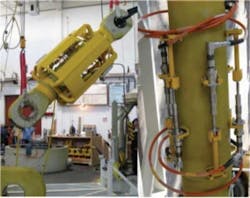Deepwater challenges free-standing riser tower integrity monitoring
Rod Edwards
BMT Scientific Marine Services Inc.
Several offshore contractors have implemented free-standing risers over the past five years. Example fields include Total’s Girassol, Exxon Mobil’s Kizomba A and Kizomba B, BP’s Greater Plutonio Block 18 offshore Angola, plus Petrobras’ P-52 offshore Brazil and its five free-standing risers at Cascade Chinook in the Gulf of Mexico. There are more deepwater installations on the horizon. Acergy, Saipem, Technip, and Heerema all have proprietary technology and offer free-standing risers for deepwater applications.
Seven riser towers in operation today have BMT Integrity Monitoring Systems. BP’s Greater Plutonio Angola block 18 Hybrid Riser Tower was the first, followed by Petrobras’ P-52 offshore Brazil and Petrobras America’s Cascade/Chinook towers. The P-52 and Cascade/Chinook projects use free-standing riser tower systems with a single riser per tower. Saipem S.A. recently ordered two Single Leg Riser Tower Monitoring Systems for delivery to West Africa. While the architecture of these systems may vary, they all have common the function to alert the operators to any degradation in the forces that stabilize the towers. The BP Greater Plutonio Block 18 System is finishing its third year of operation and the P-52 system has been installed since December of 2007. The Cascade/Chinook RTMS has been delivering data since December 2009.
These riser support concepts strive to decouple the response of the riser tower from that of its associated floater, as well as from the effect of wind-driven seas and swells. One hundred percent decoupling between floater motions and tower response cannot be achieved. The towers also experience motions induced by current. Hence, the requirement arises to track the structural response of the towers over their lifetime. However, the overriding requirement is to provide a credible, long-term assessment of the buoyancy force that stabilizes the tower. It is essential that any loss of buoyancy for these types of riser support systems be immediately brought to the attention of the operators.
Several subsystems comprise a typical RTMS. These include:
- Axial tension (tracking the buoyancy force) in the tower main structural member or supporting tethers
- Bending stresses (tracking the fatigue) on the tower main structural member
- Lateral offset of the top of the riser tower
- Attitude, linear, and angular motions of the riser tower top
- Measurement controller on the FPU with real-time displays of uplift force, stresses, cumulative fatigue damage, watch circle diagrams, and trend plots
- Either “hardwire” power and data links, or semi-autonomous acoustic links from the riser tower to the FPU/FPSO.
Direct measurement of strain in the support system is the most straightforward way to monitor the integrity of the riser tower support structure or tethers. The essential requirements for subsea riser tower strain measurements are:
- Long life-design life typically 20-25 years with no service
- Corrosion resistant
- Multiple barriers to water ingress
- No drift over design the life
- Sensitivity to temperature fluctuations and hydrostatic pressure well characterized
- Low power requirements and robust signals.
Research led BMT to adapt a technology successfully deployed subsea — i.e., pressure-balanced, oil- filled LVDT-based extensometers to measure the tensile strain in the riser tower support system. The accuracy, hysteresis, resolution, and repeatability have been established in rigorous laboratory tensile and bending calibrations:
- Accuracy: +/- 4 micro strain or better
- Resolution: Less than 0.5 micro strain
- Repeatability: Less than 1.5 micro strain
- Hysteresis: Less than 3 micro strain.
The BMT sensor assemblies are manufactured from selected corrosion-resistant alloys. The embedded LVDTs are designed to deploy in high-pressure corrosive environments. Hence, the sensor assembly has a double water ingress barrier.
Installation on riser tower
This type of riser support system consists of a central core pipe that is the tension member that supports multiple risers. The core pipe is supported by an integral buoyancy module at the top and, in some cases, by distributed buoyancy along its length. Multiple risers are supported at the top of the buoyancy element. The tensile strain in the core pipe does not provide an unequivocal estimate of the uplift force exerted by the buoyancy elements, because variation in the contents of the riser will affect the measured wall tension in the core pipe. Nonetheless, the core pipe strain is the only option, unless the assembly is supported with a single buoyancy element. It still offers a useful indication of tower stability.
The single buoyancy can-supported riser is simple and offers an unequivocal estimate of the buoyancy force that stabilizes the riser. Typically, a load spool or connection assembly carries the entire buoyancy force into the riser support structure. Regardless of the riser contents, the force/tensile strain in the spool is unaffected.
Redundancy and reliability
For a bundled riser system, the core pipe will endure significant bending moments which must be accounted for to accurately estimate the axial tension and uplift force. Aside from facilitating an accurate estimate of axial tension, the bending moment magnitude is important to track the integrity of the support structure. Even for single buoyancy can-supported risers, significant bending moments can be carried in the load link; and, if not considered, can degrade the accuracy of the estimate of uplift force. Hence, for a fully functional integrity monitoring system, BMT considers a minimum of three sensors to be appropriate. BMT normally recommends the deployment of six sensors at equally spaced intervals around any pipe in which bending and tension are expected. This provides true dual redundancy. Fifty percent of the sensors may fail, yet the tensile and bending stresses still can be reliably estimated.
As of the summer of 2010, BMT has deployed 71 sensors that have accumulated 104 sensor-years of service. The Mean Time Between Failure for these individual sensors, based upon real data, is 456,000 hours.
All of the systems described here contained pre-installed sensor assemblies. All equipment other than the sensor assembly and its protective “cage” was installed by ROV – including jumpers, receptacles, and cable immobilization devices. In recent installations, the sensors may be retrieved and replaced by a diver. However, testing is under way now on sensor assemblies that can be retrieved and replaced by ROV.
Riser top position
Monitoring the position of the top of the tower with respect to the tower base provides another robust method to estimate global bending stresses in the tower. A watch circle can be established, and warnings are provided whenever the riser top migrates out of the defined watch circle.
There are two approaches to estimate the riser top lateral position. One uses an ultra-short baseline acoustic position system (USBL) wherein the relative position of the tower top with respect to a transceiver on the FPU/FPSO is established. This relative range and bearing is combined with the Earth fixed position and attitude data from the FPU’s GPS and motion sensor to estimate of the Earth fixed position of the riser top.
A second approach uses a long baseline length (LBL) acoustic position system with transponders arrayed on the seafloor and on the top of the tower. With this system, the Earth fixed position of the riser top is derived directly from multiple ranges between the seafloor beacons and those on the riser top.
The acoustic positioning system provides the static and quasi static (T>60 seconds) lateral position of the riser top in the lateral plane. Its maximum update rate is not amenable to the accurate detection of higher frequency lateral and angular motions of the riser top. Static twist or heading as well as inclination of the top riser assembly may be important to assess the health of the tower, but not measureable with an acoustic positioning system. Asymmetric loads due to flexible jumpers may twist the tower. Detection of the static or long period “twist” requires a gyrocompass device.
BMT uses a fiber optic gyrocompass and a six degree of freedom measurement package in an atmospheric enclosure. The company has repackaged a power line modem for use in subsea applications. This design permits the simultaneous provision of power and high-speed digital communications over two wires to facilitate deployment of any motion package with digital output great distances from the FPU with minimum umbilical requirements. Where umbilicals are unavailable, an acoustic modem is provided.
Real-time displays
Graphical-user- interfaces are key components in real-time monitoring systems. BMT’s typical free-standing riser status display conveys the status of the free-standing riser graphically and numerically. A single screen shows the relationship (to scale laterally) between the FPU, the riser top, and the riser base. Attitude is displayed on dynamic galvanometer screens, while the axial tension, bending moment, and resultant stress are displayed as a vertical bar chart. All of the data is archived on a hard drive and backed up onto portable storage media devices. Typical systems have links to transfer data to the FPU’s SCADA system.
The WinMon software package includes a least squares plane fit routine that uses the six strain measurements to estimate the slope and intercept of the strain plane. An error detection routine rejects sensor readings that depart substantially from the fitted plane and then recalculates a new solution in real time. This process repeats until all outlying sensors are rejected and identified. The axial tension and the bending moment vector are then computed. To assess fatigue, the distribution of stress is computed at 12 equally spaced locations around the pipe circumference, and then a rain flow counting scheme is employed to track the cycles versus stress range at each location.
Performance to date
To date, the RTMS has performed to expectations. Data is only available for public disclosure from BP’s block 18 RTMS. Those data show the stability of the tension estimates that was available to the operators over a 15-month period. The excellent agreement between the changes in tension reported by the independent sensing systems near the bottom of the riser (-1,200 m, or -3,936 ft) and at the top (-112 m, or -367 ft) attests to the validity. Since the BP Greater Plutonio production risers’ commissioning in February 2008, the system has exhibited little if any drift.
The author
Rod Edwards, vice president of BMT Scientific Marine Services Inc., is the project manager for BMT’s contract to supply the RTMS for Cascade Chinook and was PM for the Greater Plutonio Block 18 Hybrid Riser Tower Monitoring System.
Offshore Articles Archives
View Oil and Gas Articles on PennEnergy.com



